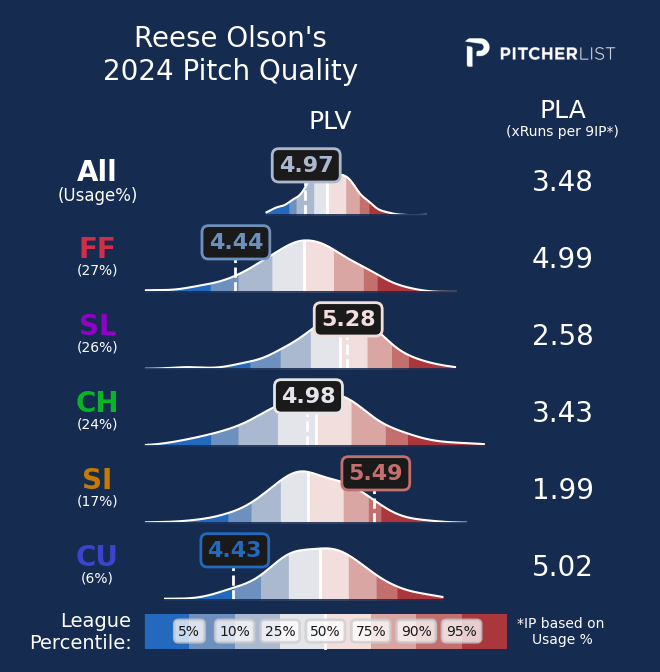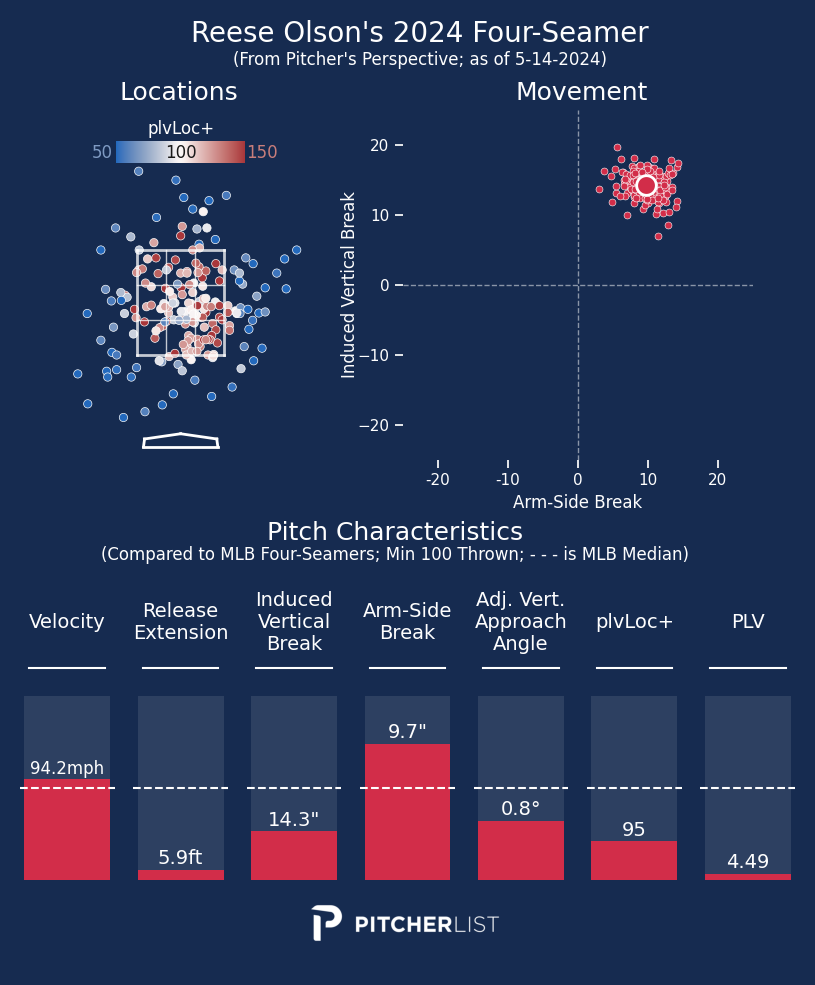We’re almost two full months into the 2024 season, and if you haven’t started yet, now’s about the time to critically analyze those players you’re still holding on to who have been maddeningly underperforming. Unless that underperformer was an early-round pick or you just really really believe in a bounce back, it’s probably time to cut your losses. As you do that, you’ll need some replacements to fill those roster spots, so let’s take a look at a few players on the other end of the spectrum who have been exceeding our expectations to determine if the good times will continue or if a correction is coming soon.
Brent Rooker, OF, Oakland Athletics
Rooker broke onto the fantasy baseball scene last year as he got his first real shot at a full-time starting gig in Oakland. He quickly proved himself to be a worthy power option, slugging 30 home runs while posting a top-10 barrel rate in the sport. As a whole, he slashed .246/.329/.488. Like most power hitters, Rooker struggled with strikeouts, punching out at a 32.7% clip, a mark high enough to raise eyebrows to wonder if he could maintain consistent production moving forward.
So far in 2024, we’ve seen even better output from the 29-year-old slugger. He’s slashing .281/.358/.578 so far this season and has already mashed his way to 11 long balls. Compare his overall output from this year to last year and things really look good for Rooker. After posting a .348 wOBA and 127 wRC+ in 2023, he’s jumped those numbers up to .402 and 167, both of which are top-12 marks in baseball.
Your initial read on Rooker’s improvement may be that he’s cut back on his swing-and-miss, but that’s not really the case, at least not to a significant point. He’s gotten better in that department ever so slightly, but not enough to warrant a large jump in production. Rooker cut his strikeout rate by about one percentage point alongside a reasonable decrease in whiff rate from 38.2% to 33.6%. He hasn’t gotten any less aggressive — in fact he’s actually swinging more often this year — he’s just making more contact. Rooker’s bumped up his contact rate to 66.2% as opposed to 61.8% in 2023, which again is a nice bump, yet it’s still in just the 9th percentile of all hitters.
While a massive surge in performance doesn’t necessarily play out in those plate discipline metrics, PLV sees Rooker as having gotten significantly better this year. Rooker has made big strides in both Decision Value and Contact Ability after being below league-average last year.

Rooker’s making better decisions about what pitches he should and shouldn’t swing at while also making stronger contact. If that doesn’t sound like a recipe for success, I don’t know what is.
Now let’s take a look where Rooker really shines, and that’s when he’s putting the bat on the ball. He set a new career-high MaxEV this season at 113.4 mph and nearly all his batted ball metrics are sterling. His xSLG and xwOBA are both 95th+ percentile. His barrel rate is 90th percentile. His hard-hit rate, LA Sweet-Spot%, and FB EV are all 80th+ percentile. There is so much loud contact in his profile.
Perhaps the biggest gain Rooker has made is hitting breaking balls. After hitting just .141 with a .281 SLG against breaking pitches in 2023, he looks like peak Barry Bonds when he sees them this year, hitting .304 with a .739 SLG against them. Take a look at this massive improvement!

Now, there should be a caveat here that while Rooker’s numbers are significantly better this year against breaking pitches, we’re taking an already small sample of Rooker’s 150 plate appearances and making it even smaller by taking into account only times he’s seen a breaking ball. There is absolutely some degree of noise in this sample. He certainly won’t end the year with the .739 SLG he currently boasts against breaking pitches.
Verdict: Legit… with a warning. Rooker’s made meaningful changes to his game and become a better hitter this year, but he still carries the same risks that come with any high-strikeout profile. Even with the improvements, his 32.5% strikeout rate is in the bottom 10 percent of hitters, making him prone to uglier stretches that you may not want to hold him through. Instead of looking at him as a totally transformed player, take your pre-season opinion of Rooker and better it slightly. He’s a worthwhile power bat to roster in most leagues, but he’s likely not going to be a league-winning pickup. In any league that counts strikeouts against your team, his value decreases a healthy margin.
Reese Olson, SP, Detroit Tigers
The beginning of Olson’s sophomore season has looked nothing short of a massive breakout. The Tigers’ 24-year-old righty has been phenomenal, wooing fantasy managers with a 2.09 ERA, 0.99 WHIP, and 41 strikeouts across 47 innings. The only blemish on his otherwise pristine profile is his lack of wins. He’s been unlucky enough to post a 0-4 record so far, and while some wins will come, it’s hard to see that being an area he can reliably help you in as part of a still-rebuilding Tigers squad.
Here’s an overview of Olson’s arsenal and how PLV sees each of his offerings:

There’s simultaneously good and bad in this chart. You love to see Olson have a wide-ranging arsenal that allows him to keep hitters off balance, but outside of the sinker, he lacks a true standout offering in the eyes of PLV.
The most troubling thing about his arsenal is that his four-seamer is not good whatsoever. It’s the pitch he relies on more than any other, and it’s one of the worst four-seamers in baseball. The pitch’s 4.44 PLV is just the 6th percentile, and the peripheral stats paint a pretty ugly picture of Olson’s primary pitch.

Those extension and IVB numbers are not what you want to see, and it’s not just PLV that doesn’t like Olson’s four-seamer. Stuff+ grades the pitch at a 71 with a mark of 100 being average, and PitchingBot’s Stuff gives it a 43 on the 20-80 scale.
Despite the ugly pitch modeling numbers, Olson’s gotten very strong results with the pitch. It’s allowed just a .194 wOBA so far, but I have to think it’s only a matter of time until that begins to change. It’s vastly outperformed its .318 xwOBA.
Now there’s plenty of good in Olson’s profile as well. Both his slider and sinker are above-average pitches. His slider has racked up strikes reliably with 38.4% CSW which is good for the 89th percentile, and while PLV gives the pitch an average grade, Stuff+ sees it at well above average at 117. He’s been able to use it both early in counts to get ahead of opposing hitters and then break it back out late to finish an at-bat. Olson’s slider has an 82nd percentile 2-Str O-Sw% and a 68th percentile PAR%. He’s also located the pitch beautifully, keeping it low and glove-side.

His sinker is also worth noting here. It’s the only pitch of his that PLV truly loves, giving it a 5.49 grade which is 93rd percentile among starters. Olson’s sinker has done exactly what you want that pitch to do: earn strikes and get groundballs. It’s carrying a nearly 70% strike rate and when it’s put in play, it’s been on the ground more often than not.
Zooming out a bit, Olson’s overall profile looks pretty similar to what we saw from him in his rookie campaign although his strikeout rate has fallen a few percentage points. One important change is that he’s done a better job of keeping his pitches low in the zone. His 65% loLoc% is in the 99th percentile.
Verdict: Legit enough to be rostered. Olson’s been a fun player to roster so far and I generally think he’ll stay that way over the course of the season. His poor fastball shape and grades give me some pause, and I think he’s in store for at least a couple of starts where the four-seamer gets punished, especially in the warmer summer months when balls will be flying all over the yard. The rest of his arsenal paints the picture of a pitcher certainly good enough to be useful in 12-teamers. I’d pick him up if he’s available.
Josh Rojas, 2B/3B, Seattle Mariners
After starting the season as a part-time player, Rojas has taken over as the Mariners’ leadoff hitter versus righties and he’s earned the promotion. In his first full season in Seattle, Rojas is slashing a sterling .301/.372/.439 to go along with three home runs and four stolen bases while providing solid on-base skills at the top of the Mariners’ lineup.
This has been a great rebound season for Rojas coming off his worst season as a pro. He was a solid option for the Diamondbacks in 2021 and 2022 producing runs at an above-league-average rate, but he struggled mightily in 2023 dropping his wRC+ to a lowly 78 over 350 plate appearances. This year, things are looking better than ever with Rojas’ 139 wRC+.
Rojas’ profile is a mixed bag. His results on contact have been very strong, but he hasn’t gotten to those results in a prototypical way. Typically barrel rate is a great estimator of success at the plate, but Rojas has never excelled in that area and he still isn’t with just a 5.3% rate. The thing he has done incredibly well is handle the bat. He’s made the most of his contact by sending his batted balls into the launch angle sweet spot, an angle between 8 and 32 degrees. Rojas’ Launch Angle Sweet-Spot% of 46.3% is in the 98th percentile among all hitters.
That elite sweet-spot rate has produced solid Statcast batted-ball statistics — a .347 xwOBA, .270 xBA, and .449 xSLG, all 69th percentile or better. Our own metrics here at Pitcher List find his batted-ball quality a little less remarkable, grading him much lower at a .232 xBA and .298 xwOBA. That mixed bag is further muddied by above-average PLV grades.

Whether or not Rojas keeps up his strong pace, it’s nice to see him have such a prevalent role. He’s hit leadoff in the last 19 games in which Seattle has faced a right-handed starting pitcher. He’s mainly taken a seat against lefties, but he did stick in the lineup the last time a left-hander was on the bump, so he may be doing enough to pull out of a strictly platoon role.
Verdict: Not Legit. I love to see Rojas succeeding after last year’s downturn, but I don’t see enough to think this performance will stick. That doesn’t mean he’ll necessarily regress to his poor 2023 performance, but I think he’s much more of a league-average bat than a 139 wRC+ moving forward. He’s still worth a look in deep fantasy formats, especially considering his prominent lineup slot, but you don’t need to rush to grab him in shallow leagues.
Featured image by Doug Carlin (@Bdougals on Twitter)
